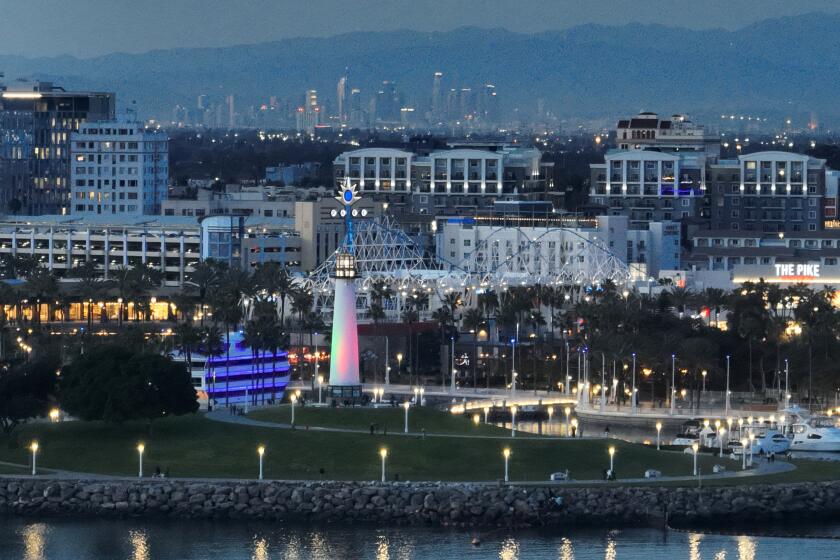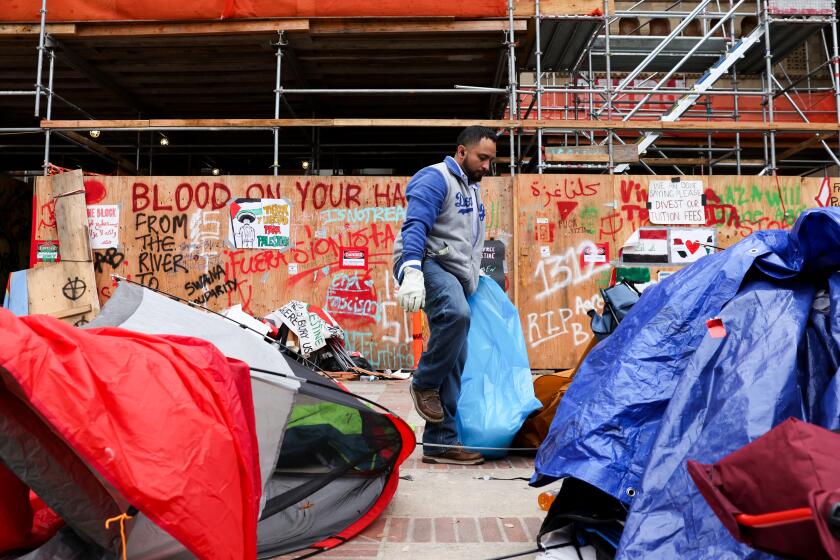‘The calm before the storm’
With extreme heat in the offing, more than 4,000 firefighters held the line Saturday against a massive wildfire threatening thousands of homes in Santa Barbara County, but made little progress in controlling a larger, out-of-control blaze ringing the Northern California coastal town of Big Sur.
Firefighters who have converged on California from throughout the nation face an ominous weather forecast as a large swath of the state is expected to be enveloped in severe heat beginning Monday. Forecasters predict erratic winds and the possibility of more fire-igniting lightning strikes.
Today’s weather may offer a brief opportunity to gain an advantage.
“That just gives us a day of lull . . . the calm before the storm,” said James Smith of the U.S. Forest Service, incident commander for the five-day-old Gap fire near Goleta.
In Big Sur, fire commanders are bracing for the heat by asking for more firefighters, especially because some crews have been on the fire lines virtually nonstop for weeks.
“Everyone here is showing a lot of concern,” said Jeremy Hamilton, a spokesman for state and federal fire crews at Big Sur, where the 71,000-acre blaze is only 5% contained.
Officials at the 8,700-acre Gap fire, the state’s top priority because more than 2,800 homes are threatened, had viewed Saturday as a strategically critical battle day.
They were largely pleased with their effort to gain 28% containment by nightfall, when notorious “sundowner” winds were expected to be lighter than the past night’s winds.
“I don’t get overconfident until we get it all, but they’re making some good work up there with the helicopters,” Smith said, “and we’ve got a few more crews in there, so it’s looking better.”
Evacuation orders, which shifted throughout the day and at times included about 2,600 homes, stretched along the foothills of Goleta and into the northeastern canyon areas. Many evacuees were allowed to return to their homes late Saturday, although warnings remained in effect.
Evacuees scattered to the homes of relatives and friends, leaving only a few families at San Marcos High School, the main shelter.
Nearly 2,200 firefighters, 19 helicopters and six air tankers helped solidify the southern border of the Gap fire 3 1/2 miles from Goleta and targeted its eastern side, an area considered of high concern because it borders hundreds of homes under evacuation orders.
If conditions remain favorable, officials hope to contain the fire’s eastern flank today.
Gov. Arnold Schwarzenegger spoke to firefighters and evacuees Saturday at the Santa Barbara command center about the statewide fire siege that began two weeks ago when lightning strikes touched off hundreds of fires in Northern and Central California.
“When you wake up one morning and have 500 fires across the state, it was a real shock to me . . . only to find the next morning there were 1,000 fires, and the next morning 1,400 fires, and then 1,700 fires igniting over 14 days,” Schwarzenegger said.
The governor pushed his emergency response initiative, which he hopes will pass with the current budget. “Something is happening, clearly. There’s more need for resources than ever before,” he said. “It’s fire season all year round. . . . It’s a different ballgame, so we have to respond.”
Santa Barbara County Fire Chief John Scherrei told the governor that since the Gap fire started Tuesday, “there were times, honestly, when I thought we’d be losing 100 homes.”
Despite a mandatory evacuation order, Rick Davis, 44, and his wife, Michelle, refused to leave their home in the hills above Santa Barbara. Davis said he had cleared 300 to 400 feet of brush and had regulation fire hoses and extra water.
“I’ll go down to the gym and people will say: ‘What have you been doing today?’ and I’ll say: ‘I’ve been doing my brush clearing’ and they’d look at me like: ‘What the heck?’ ” Davis said, adding that the vast majority of his neighbors had not done appropriate brush clearance.
About 200 miles north, the tenacious, long-running Big Sur fire continued to overwhelm firefighters. About 1,800 homes remained threatened.
As of 6 p.m. Saturday, the Big Sur blaze, which started June 21 and is called the Basin Complex fire, had burned more than 71,000 acres; 22 structures have been destroyed; and three firefighters have suffered minor heat-related injuries, said fire information officer Mark Savage. Evacuation orders extend to more than 850 people.
Even though more than 2,300 firefighters bolstered their lines, the blaze grew on the north and south, and winds were stronger than expected.
“They made progress, but the fire did as well,” said Sarah Gibson, a spokeswoman at the command center.
Some Big Sur residents have refused to evacuate. Authorities arrested property owner Ross Curtis, 48, on Friday afternoon on suspicion of setting backfires in an attempt to save his home on Apple Pie Ridge. Relatives and neighbors, who said he had since been released from jail, rushed to his defense, contending that they had to save their land from 200-foot-high flames in the absence of fire crews.
Big Sur firefighters also face the added danger of more than 100,000 dead oak trees studded through the burning forests, acting as kindling.
At the peak of the fire rampage that began June 20, some 1,783 fires burned, many ignited by lightning. So far, more than 510,000 acres from Nevada to the Pacific Ocean have burned, destroying 34 homes and 32 outbuildings, fire officials said.
Weather forecasters warned Saturday that a high-pressure ridge developing over the central Pacific will track east, squeezing hot air from the interior deserts toward the coast and limiting the cooling marine layer to the beaches.
The warming trend should begin Monday in Southern California, with temperatures expected to surpass 90 degrees in valleys and foothills, fairly typical for this time of year. By Tuesday, temperatures could approach or exceed 105 degrees. The heat wave is expected to extend through Friday. Temperatures also will soar in the typically cooler Big Sur area, peaking Wednesday, when they could surpass 90 degrees at the shore and top 100 degrees inland, with humidity only 20%.
Further complicating firefighting efforts is a monsoonal flow expected by midweek, bringing with it higher moisture levels and possible downpours, but also the threat of dangerous lightning strikes.
“You really can’t win out here,” said Rich Thompson, a National Weather Service meteorologist.
--
eric.bailey@latimes.com
--
Times staff writers Howard Blume, Mary Engel and Deborah Schoch contributed to this report.
--
(BEGIN TEXT OF INFOBOX)
How the wildfires got their names
Fires are typically named after the place they started.
The Gap fire
Named for an area of San Marcos Pass along California 154 called Windy Gap, where the fire was mistakenly reported as having originated. It actually started about 8 miles to the west. But to avoid confusion, officials decided to keep the name. The report came in at 5:30 p.m. on July 1.
The Basin Complex fire
Two factors contributed to this name: “Basin” refers to the lightning-caused fire that started near Bear Basin about 20 miles east of Big Sur on June 21 at 12:56 p.m. That fire merged with two others to form the Basin Complex fire. “Complex” refers to a command post from which firefighters manage multiple fires.
--
Source: State and federal fire officials
--
On latimes.com
Fire information
Find the latest fire news, photos, evacuation maps and road closures at latimes.com.
More to Read
Start your day right
Sign up for Essential California for news, features and recommendations from the L.A. Times and beyond in your inbox six days a week.
You may occasionally receive promotional content from the Los Angeles Times.






